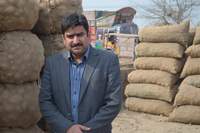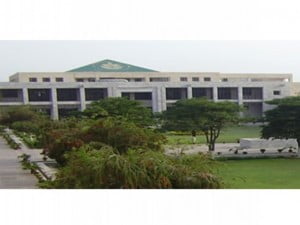By: Muhammad Mahran Aslam- Department of Plant Breeding and Genetics, University of Agriculture Faisalabad
Some consumers and environmentalists feel that inadequate effort has been made to understand the dangers in the use of transgenic crops, including their potential long-term impacts. Some consumer-advocate and environmental groups have demanded the abandonment of genetic engineering research and development. Many individuals, when confronted with conflicting and confusing statements about the effect of genetic engineering on our environment and food supply, experience a “dread fear” that inspires great anxiety. This fear can be aroused by only a minimal amount of information or, in some cases, misinformation. With people thus concerned for their health and the well-being of our planetary ecology, the issues related to their concerns need to be addressed. These issues and fears can be divided into three groups: health, environmental, and social.
Health-related issues
Allergens and toxins
People with food allergies have an unusual immune reaction when they are exposed to specific proteins, called allergens, in food. About 2 percent of people across all age groups have a food allergy of some sort. The majority of foods do not cause any allergy in the majority of people. Food-allergic people usually react only to one or a few allergens in one or two specific foods. A major safety concern raised with regard to genetic engineering technology is the risk of introducing allergens and toxins into otherwise safe foods. The Food and Drug Administration (FDA) checks to ensure that the levels of naturally occurring allergens in foods made from transgenic organisms have not significantly increased above the natural range found in conventional foods. Transgenic technology is also being used to remove the allergens from peanuts, one of most serious causes of food allergy.
Antibiotic resistance
Antibiotic resistance genes are used to identify and trace a trait of interest that has been introduced into plant cells. This technique ensures that a gene transfer during the course of genetic modification was successful. Use of these markers has raised concerns that new antibiotic resistant strains of bacteria will emerge. The rise of diseases that are resistant to treatment with common antibiotics is a serious medical concern of some opponents of genetic engineering technology. The potential risk of transfer from plants to bacteria is substantially less than the risk of normal transfer between bacteria, or between us and the bacteria that naturally occur within our alimentary tracts. Nevertheless, to be on the safe side, FDA has advised food developers to avoid using marker genes that encode resistance to clinically important antibiotics
Environmental and ecological issues
Potential gene escape and super weeds
There is a belief among some opponents of genetic engineering technology that transgenic crops might cross-pollinate with related weeds, possibly resulting in “super weeds” that become more difficult to control. One concern is that pollen transfer from glyphosate-resistant crops to related weeds can confer resistance to glyphosate. While the chance of this happening, although extremely small, is not inconceivable, resistance to a specific herbicide does not mean that the plant is resistant to other herbicides, so affected weeds could still be controlled with other products.
Some people are worried that genetic engineering could conceivably improve a plant’s ability to “escape” into the wild and produce ecological imbalances or disasters. Most crop plants have significant limitations in their growth and seed dispersal habits that prevent them from surviving long without constant nurture by humans, and they are thus unlikely to thrive in the wild as weeds. Impacts on “nontarget” species some environmentalists maintain that once transgenic crops have been released into the environment, they could have unforeseen and undesirable effects. Although transgenic crops are rigorously tested before being made commercially available, not every potential impact can be foreseen. Bt-corn, for instance, produces a very specific pesticide intended to kill only pests that feed on the corn. In 1999, however, researchers at Cornell University found that pollen from Bt-corn could kill caterpillars of the harmless Monarch butterfly. When they fed Monarch caterpillar’s milkweed dusted with Bt-corn pollen in the laboratory, half of the larvae died. But follow-up field studies showed that under real-life conditions Monarch butterfly caterpillars are highly unlikely to come into contact with pollen from Bt corn that has drifted onto milkweed leaves—or to eat enough of it to harm them.
Insecticide resistance
Another concern related to the potential impact of agricultural biotechnology on the environment involves the question of whether insect pests could develop resistance to crop-protection features of transgenic crops. There is fear that large-scale adoption of Bt-crops will result in rapid build-up of resistance in pest populations. Insects possess a remarkable capacity to adapt to selective pressures, but to date, despite widespread planting of Bt-crops, no Bt-tolerance in targeted insect pests has been detected.
Social issues
Labeling
Some consumer groups argue that foods derived from genetically engineered crops should carry a special label. In the USA, these foods currently must be labeled only if they are nutritionally different from a conventional food.
“Terminator” technology
Most farmers in the USA and elsewhere buy fresh seeds each season, particularly of such crops as corn, green peppers, and tomatoes. Anyone growing hybrid varieties must buy new seeds annually, because seeds from last year’s hybrids grown on the farm will not produce plants identical to the parent. For this same reason—to avoid random genetic diversity due to open pollination—farmers do not plant mango, avocado, or macadamia from seed; instead, they clone individual plants of known quality through techniques such as grafting. In developing countries, many farmers who are not growing hybrids save harvested seeds for replanting the next year’s crop. A technology has been developed that might be used to prevent purchasers of transgenic crop seeds from saving and replanting them. Such “terminator” seeds are genetically engineered, along with other improvements more acceptable to farmers, to produce plants with seeds that have poor germination. This forces farmers who otherwise save seed to purchase it if they wish to use these improved commercial varieties. And, in the USA, the crops engineered with various characters are sold alongside nontransgenic alternatives for which growers also typically purchase seeds annually.
Despite these mitigating circumstances, this is serious issue among organic growers and in developing countries, where the practice of saving seeds is the norm for farmers who are not growing hybrid crops. Inclusion of “terminator” genes means that these farmers cannot take advantage of improvements brought about by genetic engineering without being brought into the economic cycle that profits the seed companies. Without profit incentive, however, these companies are unlikely to invest in improving crops. This issue is analogous to that faced by pharmaceutical companies developing new medications against human diseases. Clearly, it is a difficult and divisive social issue.
Safety and regulations
Transgenic crops and their resulting foods in the United States are extensively researched and reviewed by three federal government agencies: the U.S. Department of Agriculture (USDA), the U.S. Environmental Protection Agency (EPA), and the U.S. Food and Drug Administration (FDA). Each agency is responsible for a different part of the review process. USDA has primary responsibility for determining if a new product is safe to grow, while EPA reviews the product for potential impact on the environment. FDA is concerned with protecting the consumer and has final authority to declare if a product is safe to eat.
Considerations about food from genetically engineered crops have raised a host of questions about effects on the environment, economic impacts, and eth5 BIO- 3 Use of Biotechnology in Agriculture—Benefits and Risks CTAHR — May 2003 ics. However, perhaps the most fundamental question about such food is whether it is safe and wholesome to eat. Before field testing any new transgenic crop, companies and research institutions must register with USDA for field testing permission. Researchers must ensure that pollen and plant parts of the tested plants are not released into the environment during this period.
Transgenic crops must also pass scrutiny of the EPA, which has the authority to regulate all new pesticides and genetically engineered crops. EPA is concerned with potential impacts on nontarget species and endangered or threatened species. Finally, any foods derived from transgenic crops must pass FDA inspection. Current law requires that foods from transgenic organisms must be labeled as such if their nutritional content or composition differs significantly from their conventional counterparts or if they pose any health risks. Both the National Academy of Sciences and the FDA have determined that, in general, foods derived so far from genetically engineered organisms are as safe as or safer than conventional counterparts. The main concern is remaining vigilant for potential allergens.
 I have worked with giants of agricultural input providers in Pakistan. If we provide quality products to farmers at reasonable prices and at their door step, along with guiding and introducing them to direct buyers or industry, then the existing buying and selling landscape in agricultural industry can be reshaped.
I have worked with giants of agricultural input providers in Pakistan. If we provide quality products to farmers at reasonable prices and at their door step, along with guiding and introducing them to direct buyers or industry, then the existing buying and selling landscape in agricultural industry can be reshaped.





